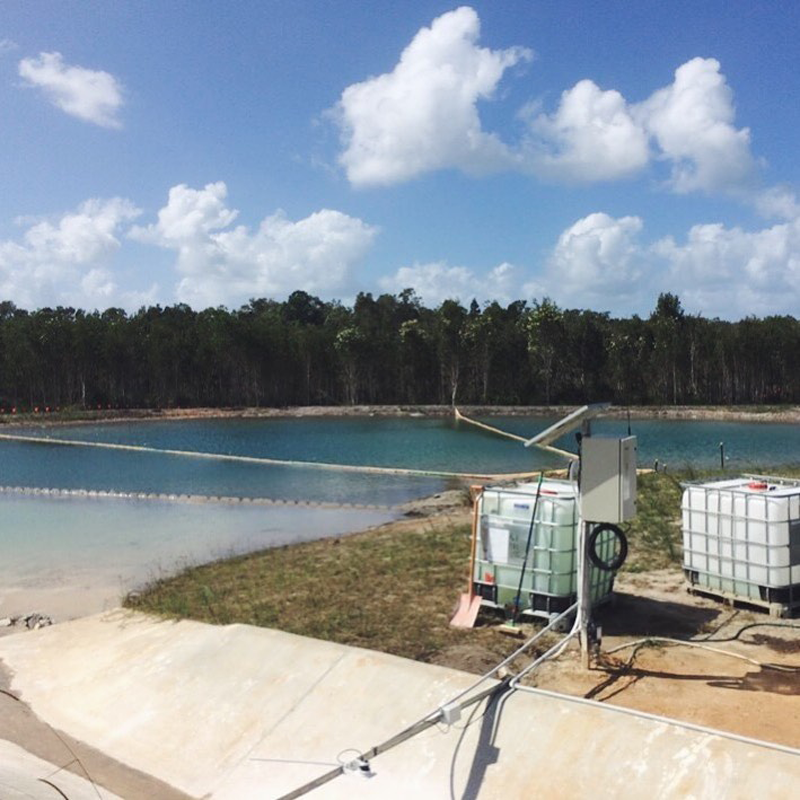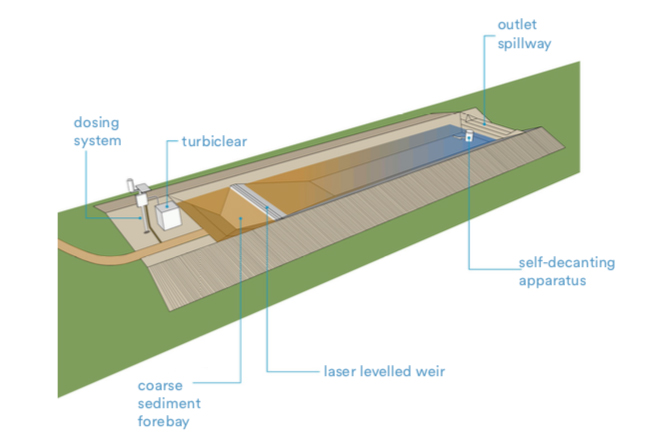Sediment Basin Solutions
Water on-site? Turbid Water Solutions.
About Sediment Basin Solutions
Sediment Basins are a type of site water management solution. Sediment basins facilitate the treatment and clarification of water on industrial, construction, agricultural and mining sites by separating sediment and contaminants from water prior to its release or re-use on the site. This separation prevents the ecological implications of on-sending sediment and other contaminants beyond the site. Turbid’s Sediment Basin Solutions represent an evolution from traditional approaches, with our High Efficiency Sediment Basins reducing the footprint and improving basin performance.
Types of Site Water Management
Turbid offers three types of site water management solutions:
Sediment Basin Solutions
Utilising an excavated basin system, Sediment Basin Solutions facilitate the treatment of water by separating sediment and contaminants from water. Read below to learn more, or contact us to discuss your site.
Industrial Solutions
Turbid Industrial Solutions are for permanent or long-term installations that require a process-related water treatment solution.
Advanced Temporary Solutions
Advanced Temporary Solutions are a short-term water management solution for sites with little or no infrastructure.
Water On Site?
Talk to our team and learn how we can help.
Where are Sediment Basin Solutions Used?
Sediment Basins Solutions are used in the construction, industrial, agricultural and mining industries, and are especially relevant on sites where the earth has been disturbed. When stormwater encounters earth that is loose or disturbed by site activities, in the absence of a site water management solution this sediment washes out with widespread ecological ramifications. Turbid’s High Efficiency Sediment Basins are deployed Australia-wide to prevent this kind of sediment pollution.
Examples of sites include:
- Residential Developments
- Industrial Developments
- Road Construction
- Municipal landfills
- Quarries
- Mine operations
- Mine Rehabilitation
- Mineral Processing facilities
- Agricultural Pursuits

Turbid High Efficiency Sediment Basins (HES)
HES Basins improve performance and reduce size constraints by up to 80% of traditional basin solutions. All of our solutions utilise our product suite, in an application customised to suit site needs. Learn more about our products here.
Sediment Basin Site Water Management Stages
Turbid Site Water Management involves 3 stages: Control, Treat and Dewater.

1. Control
Stormwater and groundwater can impact operational continuity and site compliance. Controlling how water moves through the site is essential for a successful Site Water Management solution. With a Sediment Basin Solution, water is directed or pumped into a basin where it is treated to remove sediment and contaminants. Learn more about controlling site water, or contact the team to discuss your site today.

2. Treat
Sediment basins work either by the collected water being manually treated in batches after runoff events, or autonomously treated while runoff is travelling through the basin. This facilitates the separation of sediment and other contaminants from the water. Learn more about Turbid water treatment, or contact our team to discuss your site today.

3. Dewater
After treatment, water can be released from the basin back into the environment or re-used on the site. Removing the sediment and other contaminants from water prior to releasing it prevents the problems associated with contaminated discharges. Learn more about dewatering, or contact our team to discuss your site today.
Get to know High Efficiency Sediment basins
Turbid are leading the industry with the use of HES basins. These types of basins can:
- Significantly reduce the footprint (up to one fifth) of sediment controls for both temporary and longer termed construction activities.
- Improve environmental performance.
- Significantly reduce the frequency of turbid discharges off-site resulting in less complaints and less risk of enforcement from regulators.
- Provides a source of construction water.
- Reduce manual handling requirements resulting in lower costs for flocculation of basins and improved WH&S.
- When considered early as part of an integrated stormwater management approach it can minimise land take for permanent stormwater controls.
- Manage construction phase sediment loading risks to WSUD assets, thereby allowing WSUD assets in urban developments to be constructed earlier, potentially saving time and money for developers.
How HES basins work
High Efficiency Sediment (HES) basins work on a continuous-flow basis rather than the batch process that traditional sediment basins operate by. This means that treatment and discharge occur throughout a rainfall event rather than at the end of an event. This continuous-flow approach offers many advantages, the main one being that a much greater volume of runoff can be treated for a given basin size, compared to traditional batch basins.
Key Components Include:
DOSING SYSTEM:
An automated system is provided at the start of the basin to deliver a dose of treatment product to enhance the settlement of fine and dispersive sediment. The dosing system can be either triggered by rainfall or can be based on the incoming flow rate.
COARSE SEDIMENT FOREBAY:
This is the first cell of the basin and is where the majority of mixing of the treatment product with run off occurs and is also where the majority of the coarse sediment is deposited.
LEVEL-SPREADER/WEIR:
The level-spreader acts to distribute the flow across the full width of the basin so that velocities are minimised and settling is enhanced.
SETTLING ZONE:
This second cell of the basin is where settling of fine and dispersive sediment occurs. The fine particle size and slow settling velocities require this cell to be large so that non-turbulent settling can occur.
OUTLET STRUCTURES:
There are two different types of HES basins specified in IECA (2016 Addendum) – Type A and Type B. The main difference between these types is the outlet structure. Type A basins have a floating-decant as the primary outlet which ‘skims’ water from the top of the water column and allows the basin to be largely emptied between events. Type B has only a spillway outlet and remains full following an event.

Discuss Your Site
If you’re dealing with water on-site, talk to Turbid Water Solutions today.
